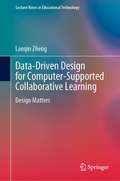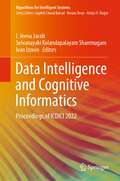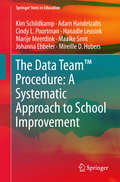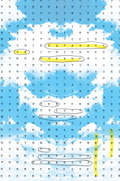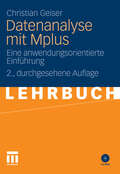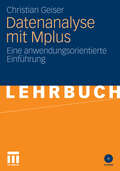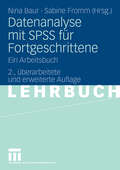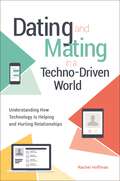- Table View
- List View
Data Analytics for the Social Sciences: Applications in R
by G. David GarsonData Analytics for the Social Sciences is an introductory, graduate-level treatment of data analytics for social science. It features applications in the R language, arguably the fastest growing and leading statistical tool for researchers. The book starts with an ethics chapter on the uses and potential abuses of data analytics. Chapters 2 and 3 show how to implement a broad range of statistical procedures in R. Chapters 4 and 5 deal with regression and classification trees and with random forests. Chapter 6 deals with machine learning models and the "caret" package, which makes available to the researcher hundreds of models. Chapter 7 deals with neural network analysis, and Chapter 8 deals with network analysis and visualization of network data. A final chapter treats text analysis, including web scraping, comparative word frequency tables, word clouds, word maps, sentiment analysis, topic analysis, and more. All empirical chapters have two "Quick Start" exercises designed to allow quick immersion in chapter topics, followed by "In Depth" coverage. Data are available for all examples and runnable R code is provided in a "Command Summary". An appendix provides an extended tutorial on R and RStudio. Almost 30 online supplements provide information for the complete book, "books within the book" on a variety of topics, such as agent-based modeling. Rather than focusing on equations, derivations, and proofs, this book emphasizes hands-on obtaining of output for various social science models and how to interpret the output. It is suitable for all advanced level undergraduate and graduate students learning statistical data analysis.
Data Analytics for the Social Sciences: Applications in R
by G. David GarsonData Analytics for the Social Sciences is an introductory, graduate-level treatment of data analytics for social science. It features applications in the R language, arguably the fastest growing and leading statistical tool for researchers. The book starts with an ethics chapter on the uses and potential abuses of data analytics. Chapters 2 and 3 show how to implement a broad range of statistical procedures in R. Chapters 4 and 5 deal with regression and classification trees and with random forests. Chapter 6 deals with machine learning models and the "caret" package, which makes available to the researcher hundreds of models. Chapter 7 deals with neural network analysis, and Chapter 8 deals with network analysis and visualization of network data. A final chapter treats text analysis, including web scraping, comparative word frequency tables, word clouds, word maps, sentiment analysis, topic analysis, and more. All empirical chapters have two "Quick Start" exercises designed to allow quick immersion in chapter topics, followed by "In Depth" coverage. Data are available for all examples and runnable R code is provided in a "Command Summary". An appendix provides an extended tutorial on R and RStudio. Almost 30 online supplements provide information for the complete book, "books within the book" on a variety of topics, such as agent-based modeling. Rather than focusing on equations, derivations, and proofs, this book emphasizes hands-on obtaining of output for various social science models and how to interpret the output. It is suitable for all advanced level undergraduate and graduate students learning statistical data analysis.
Data-based Decision Making in Education: Challenges and Opportunities (Studies in Educational Leadership #17)
by Kim Schildkamp, Mei Kuin Lai and Lorna EarlIn a context where schools are held more and more accountable for the education they provide, data-based decision making has become increasingly important. This book brings together scholars from several countries to examine data-based decision making. Data-based decision making in this book refers to making decisions based on a broad range of evidence, such as scores on students’ assessments, classroom observations etc.This book supports policy-makers, people working with schools, researchers and school leaders and teachers in the use of data, by bringing together the current research conducted on data use across multiple countries into a single volume. Some of these studies are ‘best practice’ studies, where effective data use has led to improvements in student learning. Others provide insight into challenges in both policy and practice environments. Each of them draws on research and literature in the field.
Data-Driven Design for Computer-Supported Collaborative Learning: Design Matters (Lecture Notes in Educational Technology)
by Lanqin ZhengThis book highlights the importance of design in computer-supported collaborative learning (CSCL) by proposing data-driven design and assessment. It addresses data-driven design, which focuses on the processing of data and on improving design quality based on analysis results, in three main sections. The first section explains how to design collaborative learning activities based on data-driven design approaches, while the second shares illustrative examples of computer-supported collaborative learning activities. In turn, the third and last section demonstrates how to evaluate design quality and the fidelity of enactment based on design-centered research.The book features several examples of innovative data-driven design approaches to optimizing collaborative learning activities; highlights innovative CSCL activities in authentic learning environments; demonstrates how learning analytics can be used to optimize CSCL design; and discusses the design-centered research approach to evaluating the alignment between design and enactment in CSCL. Given its scope, it will be of interest to a broad readership including researchers, educators, practitioners, and students in the field of collaborative learning, as well as the rapidly growing community of people who are interested in optimizing learning performance with CSCL.
Data Intelligence and Cognitive Informatics: Proceedings of ICDICI 2022 (Algorithms for Intelligent Systems)
by I. Jeena Jacob Selvanayaki Kolandapalayam Shanmugam Ivan IzoninThe book is a collection of peer-reviewed best selected research papers presented at the International Conference on Data Intelligence and Cognitive Informatics (ICDICI 2021), organized by SCAD College of Engineering and Technology, Tirunelveli, India, during July 6–7, 2022. This book discusses new cognitive informatics tools, algorithms and methods that mimic the mechanisms of the human brain which lead to an impending revolution in understating a large amount of data generated by various smart applications. The book includes novel work in data intelligence domain which combines with the increasing efforts of artificial intelligence, machine learning, deep learning and cognitive science to study and develop a deeper understanding of the information processing systems.
Data, Methods and Theory in the Organizational Sciences: A New Synthesis (SIOP Organizational Frontiers Series)
by Kevin R. MurphyData, Methods and Theory in the Organizational Sciences explores the long-term evolution and changing relationships between data, methods, and theory in the organizational sciences. In the last 50 years, theory has come to dominate research and scholarship in these fields, yet the emergence of big data, as well as the increasing use of archival data sets and meta-analytic methods to test empirical hypotheses, has upset this order. This volume examines the evolving relationship between data, methods, and theory and suggests new ways of thinking about the role of each in the development and presentation of research in organizations. This volume utilizes the latest thinking from experts in a wide range of fields on the topics of data, methods, and theory and uses this knowledge to explore the ways in which behavior in organizations has been studied. This volume also argues that the current focus on theory is both unhealthy for the field and unsustainable, and it provides more successful ways theory can be used to support and structure research, and demonstrates the most effective techniques for analyzing and making sense of data. This is an essential resource for researchers, professionals, and educators who are looking to rethink their current approaches to research, and who are interested in creating more useful and more interpretable research in the organizational sciences.
Data, Methods and Theory in the Organizational Sciences: A New Synthesis (SIOP Organizational Frontiers Series)
by Kevin R. MurphyData, Methods and Theory in the Organizational Sciences explores the long-term evolution and changing relationships between data, methods, and theory in the organizational sciences. In the last 50 years, theory has come to dominate research and scholarship in these fields, yet the emergence of big data, as well as the increasing use of archival data sets and meta-analytic methods to test empirical hypotheses, has upset this order. This volume examines the evolving relationship between data, methods, and theory and suggests new ways of thinking about the role of each in the development and presentation of research in organizations. This volume utilizes the latest thinking from experts in a wide range of fields on the topics of data, methods, and theory and uses this knowledge to explore the ways in which behavior in organizations has been studied. This volume also argues that the current focus on theory is both unhealthy for the field and unsustainable, and it provides more successful ways theory can be used to support and structure research, and demonstrates the most effective techniques for analyzing and making sense of data. This is an essential resource for researchers, professionals, and educators who are looking to rethink their current approaches to research, and who are interested in creating more useful and more interpretable research in the organizational sciences.
Data Science for Neuroimaging: An Introduction
by Ariel Rokem Tal YarkoniData science methods and tools—including programming, data management, visualization, and machine learning—and their application to neuroimaging researchAs neuroimaging turns toward data-intensive discovery, researchers in the field must learn to access, manage, and analyze datasets at unprecedented scales. Concerns about reproducibility and increased rigor in reporting of scientific results also demand higher standards of computational practice. This book offers neuroimaging researchers an introduction to data science, presenting methods, tools, and approaches that facilitate automated, reproducible, and scalable analysis and understanding of data. Through guided, hands-on explorations of openly available neuroimaging datasets, the book explains such elements of data science as programming, data management, visualization, and machine learning, and describes their application to neuroimaging. Readers will come away with broadly relevant data science skills that they can easily translate to their own questions.• Fills the need for an authoritative resource on data science for neuroimaging researchers• Strong emphasis on programming• Provides extensive code examples written in the Python programming language• Draws on openly available neuroimaging datasets for examples• Written entirely in the Jupyter notebook format, so the code examples can be executed, modified, and re-executed as part of the learning process
Data Science, Learning by Latent Structures, and Knowledge Discovery (Studies in Classification, Data Analysis, and Knowledge Organization)
by Berthold Lausen Sabine Krolak-Schwerdt Matthias BöhmerThis volume comprises papers dedicated to data science and the extraction of knowledge from many types of data: structural, quantitative, or statistical approaches for the analysis of data; advances in classification, clustering and pattern recognition methods; strategies for modeling complex data and mining large data sets; applications of advanced methods in specific domains of practice. The contributions offer interesting applications to various disciplines such as psychology, biology, medical and health sciences; economics, marketing, banking and finance; engineering; geography and geology; archeology, sociology, educational sciences, linguistics and musicology; library science. The book contains the selected and peer-reviewed papers presented during the European Conference on Data Analysis (ECDA 2013) which was jointly held by the German Classification Society (GfKl) and the French-speaking Classification Society (SFC) in July 2013 at the University of Luxembourg.
The Data Team™ Procedure: A Systematic Approach to School Improvement (Springer Texts in Education)
by Kim Schildkamp Adam Handelzalts Cindy L. Poortman Hanadie Leusink Marije Meerdink Maaike Smit Johanna Ebbeler Mireille D. HubersThis book describes the Data Team Procedure: a method for data-based decision making that can help schools to improve their quality. It involves the use of teams consisting of 4-6 teachers, 1-2 school leaders and a data expert. The members of the team collaboratively learn how to use data to solve an educational problem within the school, adopting a systematic approach. The data team procedure is an iterative and cyclic procedure consisting of eight steps. The data team members are trained in the data team procedure by a coach. The coach visits the data team’s school regularly for a meeting and facilitates working according to the systematic procedure. Teams participate in data analysis workshops for more specific support. Divided into three parts, the book first describes the importance of data use and the data team procedure. Next, it describes two cases. The first case concerns a data team working on a school level problem: Reducing grade repetition. The second case concerns a data team working on a classroom level problem: low student achievement in English language. The last part of the book explains what it means to implement the data team procedure in the school, the conditions needed for implementing the data team procedure, and the factors that may hinder or support the use of data in data teams.
Database of Dreams: The Lost Quest to Catalog Humanity
by Rebecca LemovJust a few years before the dawn of the digital age, Harvard psychologist Bert Kaplan set out to build the largest database of sociological information ever assembled. It was the mid-1950s, and social scientists were entranced by the human insights promised by Rorschach tests and other innovative scientific protocols. Kaplan, along with anthropologist A. I. Hallowell and a team of researchers, sought out a varied range of non-European subjects among remote and largely non-literate peoples around the globe. Recording their dreams, stories, and innermost thoughts in a vast database, Kaplan envisioned future researchers accessing the data through the cutting-edge Readex machine. Almost immediately, however, technological developments and the obsolescence of the theoretical framework rendered the project irrelevant, and eventually it was forgotten.
Daten und Statistik: Eine praktische Einführung für den Bachelor in Psychologie und Sozialwissenschaften
by Gabriele HornsteinerDaten sind Gold. Dieses Gold liegt auf der Straße –allerdings meistens in unansehnlichen Erzklumpen. Man findet es beispielsweise in Unternehmensdatenbanken oder bei speziellen Erhebungen. Wie man das Goldgewinnt - also Daten richtig auswertet und die Auswertung interpretiert– das findet sich in Daten und Statistik fürSozialwissenschaftler und Psychologen. Dieses leicht verständlich geschriebeneKompaktbuch zum systematischen und anwendungsnahen Einstieg richtet sich an Studierende,die in wissenschaftlichen Arbeiten mit diversen Daten konfrontiert sind, und an in statistischen Methoden unerfahrene Praktiker. Mit den anschaulichen undalltagsnahen Beispielen wird es für jeden Leser eine wertvolle Hilfe sein.
Datenanalyse mit Mplus: Eine anwendungsorientierte Einführung
by Christian GeiserStrukturgleichungsmodelle gehören mittlerweile zu den etablierten statistischen Methoden in den Sozialwissenschaften und eignen sich für die Beantwortung einer Vielzahl von Fragestellungen. Das Analyseprogramm Mplus erfreut sich als eines der aktuellsten, flexibelsten und anwenderfreundlichsten Statistikprogramme zunehmender Beliebtheit. Praxisnah, mit zahlreichen Beispielen, Probedatensätzen und Abbildungen führt der Autor Schritt für Schritt in die Grundlagen der Handhabung von Mplus (Version 5) ein, und beschreibt die Anwendung grundlegender Analyseverfahren. Dabei werden nicht nur konventionelle Strukturgleichungsmodelle, sondern auch Strukturgleichungsmodelle der Veränderungsmessung sowie Mehrebenenregressionsmodelle und Latent-Class-Analysen besprochen.
Datenanalyse mit Mplus: Eine anwendungsorientierte Einführung
by Christian GeiserStrukturgleichungsmodelle gehören mittlerweile zu den etablierten statistischen Methoden in den Sozialwissenschaften und eignen sich für die Beantwortung einer Vielzahl von Fragestellungen. Das Analyseprogramm Mplus erfreut sich als eines der aktuellsten, flexibelsten und anwenderfreundlichsten Statistikprogramme zunehmender Beliebtheit. Praxisnah, mit zahlreichen Beispielen, Probedatensätzen und Abbildungen führt der Autor Schritt für Schritt in die Grundlagen der Handhabung von Mplus (Version 5) ein, und beschreibt die Anwendung grundlegender Analyseverfahren. Dabei werden nicht nur konventionelle Strukturgleichungsmodelle, sondern auch Strukturgleichungsmodelle der Veränderungsmessung sowie Mehrebenenregressionsmodelle und Latent-Class-Analysen besprochen.
Datenanalyse mit SPSS für Fortgeschrittene: Ein Arbeitsbuch
by Nina Baur Sabine FrommDas Buch bietet eine verständliche und anwendungsorientierte Einführung in das fortgeschrittene Arbeiten mit SPSS, der wichtigsten Software im Bereich der empirischen Sozialforschung. Anschauliche Beispiele aus den Sozialwissenschaften und eine beiliegende CD runden das didaktische Konzept des Buches ab.
Datenanalyse mit SPSS für Fortgeschrittene: Ein Arbeitsbuch
by Nina Baur Sabine FrommDas Buch bietet eine verständliche und anwendungsorientierte Einführung in das fortgeschrittene Arbeiten mit SPSS, der wichtigsten Software im Bereich der empirischen Sozialforschung. Anschauliche Beispiele aus den Sozialwissenschaften und umfassendes Zusatzmaterial auf der Homepage zum Buch runden das didaktische Konzept des Buches ab.
Datenanalyse mit SPSS für Fortgeschrittene 1: Datenaufbereitung und uni- und bivariate Statistik
by Leila Akremi Nina Baur Sabine FrommDas Buch ist als Arbeitsprogramm für Studierende der Sozialwissenschaften konzipiert: Ziel ist es, sozialwissenschaftliche Fragestellungen in statistische Auswertungskonzepte umzusetzen und diese mit der Statistik-Software SPSS selbständig bearbeiten zu können. Dazu werden typische Probleme der Datenbereinigung und -konstruktion ebenso behandelt wie grundlegende Techniken und Fragestellungen deskriptiver und induktiver univariater und bivariater Statistik. Was dieses Buch von anderen unterscheidet, sind sein starker Praxisbezug und sein Kurscharakter: Die Autoren verfügen über langjährige Lehr- und Forschungserfahrung in der empirischen Sozialforschung und im Data Mining.
Dating and Mating in a Techno-Driven World: Understanding How Technology Is Helping and Hurting Relationships (Sex, Love, and Psychology)
by Rachel HoffmanAuthored by a sex therapist who regularly works with clients wanting to improve their relationships, this book explains how technology can create conflict or additional anxiety and discloses techniques to help individuals gain confidence or strengthen their personal relationships.The statistics are telling: 85 percent of all adults use the Internet; 88 percent use email; 91 percent own cell phones; 56 percent own smartphones; 73 percent send and receive text messages; and 67 percent use social networking sites. The advent of personal communication devices and ubiquitous connectivity has dramatically shifted the way we communicate, and as a result, the way we date and pursue relationships has changed. The share of 18- to 24-year-olds who use online dating has roughly tripled from 10 percent in 2013 to 27 percent today. Modern dating techniques and technology-enabled interpersonal communication have resulted in very distinct emotional side effects.Dating and Mating in a Techno-Driven World explores dating in our 21st-century world with a unique approach, providing understandable information for anyone who is dating or seeking a long-term relationship while also serving as a clinical guide for therapists who want to learn how to treat individuals and especially couples presenting with some sort of issue related to technology. Instead of simply offering an analysis of the trends that are occurring, author Rachel Hoffman addresses the interpersonal problems and conflicts that result from digital or remote communication and "courting" and explains how to treat them. The topics addressed include utilizing dating apps, the effects of social media on relationships, and how technology can be distracting in relationships. Each chapter of the book supplies a case study or vignette, an analysis of the situation, research findings related to the topic, and clinical information that identifies the implications for therapists working with individuals or couples with a similar experience.
Dating and Mating in a Techno-Driven World: Understanding How Technology Is Helping and Hurting Relationships (Sex, Love, and Psychology)
by Rachel HoffmanAuthored by a sex therapist who regularly works with clients wanting to improve their relationships, this book explains how technology can create conflict or additional anxiety and discloses techniques to help individuals gain confidence or strengthen their personal relationships.The statistics are telling: 85 percent of all adults use the Internet; 88 percent use email; 91 percent own cell phones; 56 percent own smartphones; 73 percent send and receive text messages; and 67 percent use social networking sites. The advent of personal communication devices and ubiquitous connectivity has dramatically shifted the way we communicate, and as a result, the way we date and pursue relationships has changed. The share of 18- to 24-year-olds who use online dating has roughly tripled from 10 percent in 2013 to 27 percent today. Modern dating techniques and technology-enabled interpersonal communication have resulted in very distinct emotional side effects.Dating and Mating in a Techno-Driven World explores dating in our 21st-century world with a unique approach, providing understandable information for anyone who is dating or seeking a long-term relationship while also serving as a clinical guide for therapists who want to learn how to treat individuals and especially couples presenting with some sort of issue related to technology. Instead of simply offering an analysis of the trends that are occurring, author Rachel Hoffman addresses the interpersonal problems and conflicts that result from digital or remote communication and "courting" and explains how to treat them. The topics addressed include utilizing dating apps, the effects of social media on relationships, and how technology can be distracting in relationships. Each chapter of the book supplies a case study or vignette, an analysis of the situation, research findings related to the topic, and clinical information that identifies the implications for therapists working with individuals or couples with a similar experience.
Daughtering and Mothering: Female Subjectivity Reanalysed
by Janneke Van Mens-Verhulst Karlein Schreurs Liesbeth WoertmanThis book provides analyses of many aspects of mother-daughter relationships, starting from the premise that daughters and mothers both take an active part in shaping their relationship. It discusses contextual issues, examining women's roles in therapy, management and education.
Daughtering and Mothering: Female Subjectivity Reanalysed
by K. M. G. Schreurs L. Woerton J. Van Mens-VerhulstThis book provides analyses of many aspects of mother-daughter relationships, starting from the premise that daughters and mothers both take an active part in shaping their relationship. It discusses contextual issues, examining women's roles in therapy, management and education.
Daughters of Madness: Growing Up and Older with a Mentally Ill Mother (Women's Psychology)
by Susan L. Ph.D.June was 9 years old when she came home from school and her schizophrenic mother met her at the door, angrily demanding to know, Who the hell are you? What are you doing in my house? Tess's mother would wait outside church, then scream at family friends as they emerged, accusing them of spying and plotting to kill her. Five-year-old Tess and her 7-year-old brother would cry and beg their mother to take them home as onlookers stared. These are just two of the stories among dozens gathered for this book. The children, now adults, grew up with mentally ill mothers at a time when mental illness was even more stigmatizing than it is today. They are what Nathiel calls the daughters of madness, and their young lives were lived on shaky ground. Telling someone that there's mental illness in her family, and watching the reaction is not for the faint-hearted, the therapist says, quoting another's research. Nathiel adds, Telling them it is your mother who's mentally ill certainly ups the ante. A veteran therapist with 35 years experience, Nathiel takes us into this traumatic world—each of her chanpters covering a major developmental period for the daughter of a mentally ill mother—and then explains how these now-adult daughters faced and coped with their mothers' illness.While the stories of these daughters are central to the book, Nathiel also offers her professional insights into exactly how maternal impairment affects infants, children, and adolescents. Women, significantly more than men, are often diagnosed with serious mental illness after they become parents. So what effect does a mentally ill mother have on a growing child, teenager or adult daughter, who looks to her not only for the deepest and most abiding love, but also a sense of what the world is all about? Nathiel also makes accessible the latest research on interpersonal neurobiology, attachment, and the way a child's brain and mind develop in the contest of that relationship.
David and Goliath: Underdogs, Misfits and the Art of Battling Giants
by Malcolm GladwellWhy do underdogs succeed so much more than we expect? How do the weak outsmart the strong? In David and Goliath Malcolm Gladwell, no.1 bestselling author of The Tipping Point, Blink, Outliers and What the Dog Saw, takes us on a scintillating and surprising journey through the hidden dynamics that shape the balance of power between the small and the mighty.From the conflicts in Northern Ireland, through the tactics of civil rights leaders and the problem of privilege, Gladwell demonstrates how we misunderstand the true meaning of advantage and disadvantage. When does a traumatic childhood work in someone's favour? How can a disability leave someone better off? And do you really want your child to go to the best school he or she can get into? David and Goliath draws on the stories of remarkable underdogs, history, science, psychology and on Malcolm Gladwell's unparalleled ability to make the connections others miss. It's a brilliant, illuminating book that overturns conventional thinking about power and advantage.'A global phenomenon... there is, it seems, no subject over which he cannot scatter some magic dust' Observer
Dawn: The Origins of Language and the Modern Human Mind
by Rik SmitsIn this work, originally published in Dutch, Rik Smits theorizes that language could not have developed originally as a system of communication. It is, instead, the result of combining separate abilities, each of which developed independently to aid the survival of early humans. Lacking strength and speed, man relies on wisdom for survival. Smits theorizes that human skills in calculation and estimation continued to develop until they were sufficient to accommodate a system as complex as grammar. Only after our linguistic ability emerged could humans think logically and share our reasoning with others, at which point almost everything we now call culture began to flourish. Smits concludes that language cannot have long predated the invention of agriculture in the Middle East, some 14,000 years ago. The huge advance in civilization represented by language made abstract powers of reasoning indispensable for the first time, along with highly developed concepts of identity, past, present, and future, all of which rely upon language. This explanation of the origins of language throws new light on cave paintings by Cro-Magnon man, whose masterpieces date from about 40,000 to 15,000 years ago. Anatomically Cro-Magnons were modern humans, but they had no language in the modern sense. Their absence of language gave them no true sense of individual identity. This translation was made possible by a grant from the Dutch Foundation for Literature.
Dawn: The Origins of Language and the Modern Human Mind
by Rik SmitsIn this work, originally published in Dutch, Rik Smits theorizes that language could not have developed originally as a system of communication. It is, instead, the result of combining separate abilities, each of which developed independently to aid the survival of early humans. Lacking strength and speed, man relies on wisdom for survival. Smits theorizes that human skills in calculation and estimation continued to develop until they were sufficient to accommodate a system as complex as grammar. Only after our linguistic ability emerged could humans think logically and share our reasoning with others, at which point almost everything we now call culture began to flourish. Smits concludes that language cannot have long predated the invention of agriculture in the Middle East, some 14,000 years ago. The huge advance in civilization represented by language made abstract powers of reasoning indispensable for the first time, along with highly developed concepts of identity, past, present, and future, all of which rely upon language. This explanation of the origins of language throws new light on cave paintings by Cro-Magnon man, whose masterpieces date from about 40,000 to 15,000 years ago. Anatomically Cro-Magnons were modern humans, but they had no language in the modern sense. Their absence of language gave them no true sense of individual identity. This translation was made possible by a grant from the Dutch Foundation for Literature.


